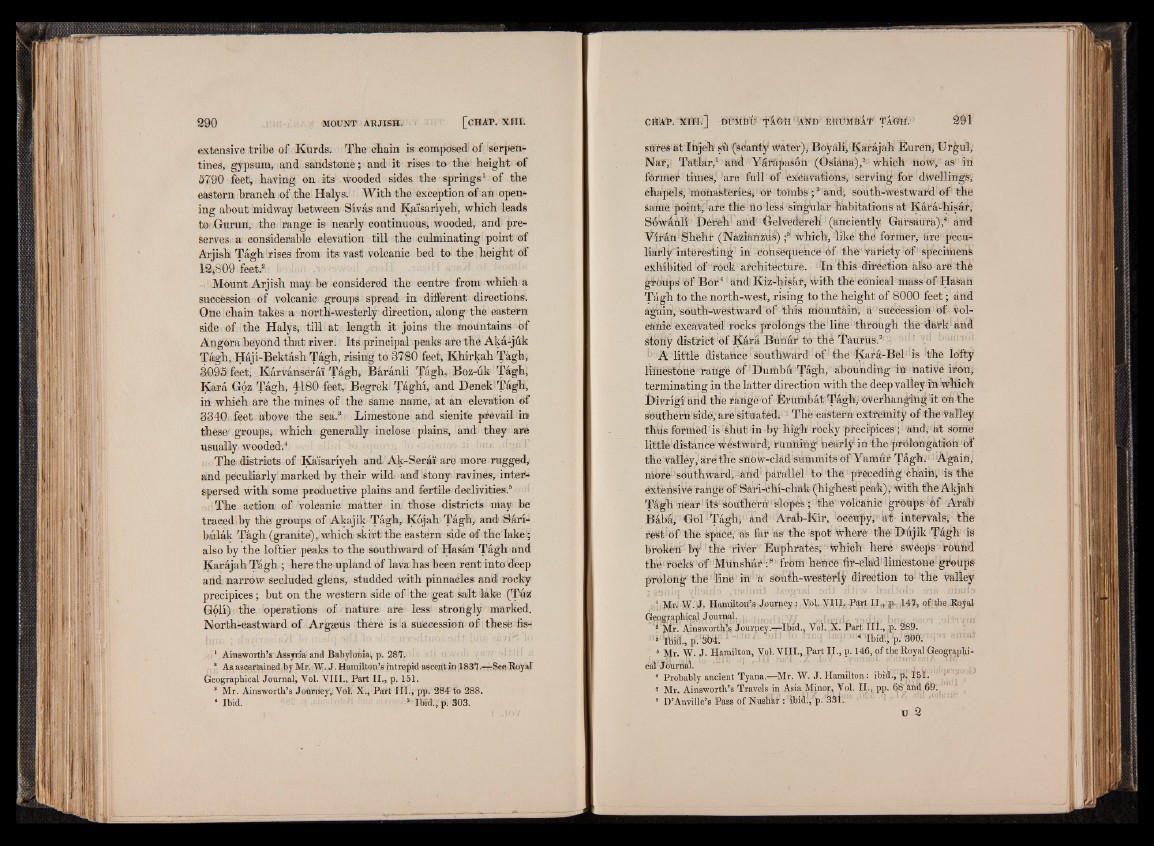
extensive tribe of Kurds, The chain is eoinpOsed of serpentines,
gypsum, and sandstone; and it rises to the height of
5790 feet, having on its wooded sides the springs1 of the
eastern branch of the Ilalys. With the exception of an opening
about midway between Sivas and Ka'isariyeh, which leads
to (Inrun, the range is nearly continuous, wooded, and preserves,
a: considerable elevation till the culminating point of
Arjish Tagh rises from its vast volcanic bed to the height of
12,809 feet..2
. Mount Arjish may be considered the centre from which a
succession of volcanic groups spread in different direction^.
One chain takes, a north-westerly direction, along the eastern
side of the Halys, till, at length it joins the; mountains Of
Angora beyond that river, Its principal peaks are the Aka-jdk
Tagh, Haji-BektAsh Tagh, rising to 3780 feet, Khirkah Tagh,.
3995: feet, Karvanserai Tagh, Baranli Tagh, Boz-uk Tagh;
Kara Goz Tagh, 4180 feet, Begrek Taglii, and BenekiTAghi,
in which are the mines of the Same name, at an elevation of
3340 feet; above the sea.? Limestone and sienitfe pievhilfii*
these groups*: which generally inclose plains, and they are
usually wooded.4
The districts of Ka'isariyeh and Ak-Serai are more rugged;
and peculiarly marked by their wild and stony ravines, interspersed
with some productive plains and fertile declivities.5
The action of volcanic matter in those districts may be
traced by the groups of Akajik Tagh, Kojah Tagh, and S Ari-
hulak Tagh (granite), which skirt the eastern side of the lake;
also by the loftier peaks to the southward of Hasan Tagh and
Karajah Tagh ; here the upland of lavahasbeen rent into deep
and narrow secluded glens, studded with pinnacles and rocky
precipices; but on the western side of the geat salt lake (Tuz
Goli) the. operations of nature are less strongly marked.
North-eastward of ArgmUs there is a succession of these fis-
. 1 Ainsworth^ Assyria and Babylonia, p. 284.
8 As ascertained by Mr. W. J . Hamilton’s intrepid ascent in 1837.—See. Royal
Geographical Journal, Vol. VIII., Part II., p. 151.
8 Mr. Ainsworth’s Jourriey, Vol. X., Part III., pp. 284' to 288.
4 Ibid. . 5 Ibid., p. 303.
sbfëS at Ihjefe’ sù (SCafïtÿ Water); Borali;Karâjaih Ëurert; Urguï;
Nar, Tatlar,' atid YarfipaSóli (Osiatla),2 which bow, as in
former times, 'are full of exCixvatiobs,;iserving for dwellings,
ChapelS; mòbàbtbfieàf OrtotebS1;*‘And, south-westward of the
saiiië point.arfe the bo less singular habitations at KArâ-hisâr,
Séwâitli Dèfeh' and Gelvedéréh (anciently Gurshura),4 and
Vhan Shelir (î^aizianàtis) f which, like thé forine?, are peculiarly
interesting iff eôhsëdbehcë bf the furieiy of' Specimens
exhibited of rock architecture. IntnisdirCCtidn al-SO are thè
té blips' ;óf Bob6 ’abd Kiz-hisar, Mrith the conical mtìssbfHaWb
Tagh to the north-west, rising to the height of 8000 feet ; and
again, 'soiith-wCStVvard of this mountain, a 'succession of Vol-
chiiie excàVâtéd rOcks prolongs thelifiethrOugli the dark and
stohy district bf KàràBübâr to f hé Taurus.^-
A little distance! southward>of the KaM-Bel; is thé lofty
limestone Tange of Dumbii Tagh, abounding ili bativé iron,
terminating in the latter direction with the deep valley lh which
Bivrigi itnd the range of KrumbAt Tagh, overhanging it ob the
southernSiffé; aré'situafèdi ' Thkeastern extremity of the valley
tliiis formed ■ is'shut in by high rocky precipices' j1 and,1 id Some
little di'staricexvestWard, riinbing nearly in the prolongation of
the valley;Uré thè SbùW-clad summitsbfYamûr Tâgh. Again;
more southward, and parallel fertile piHWeding'Chaih; is the
extensive rabgc of Sark;hi-chrtk (highest pCnk), with the Akjtth
Tagli near ifo!Southern;slopès ;;tb e volcanic 'groups-Of Arith
BAbAfGol: tagh, And ■ Arab-Kh, foc'èwpÿpbt intervals; the
rest I Of> thè Space, as far as the W Where the Diijik Tâgh is
broken by thè i'iver KuphrftiAs, Which here sweeps round
the1 rocks of MUbshàr fròtte hence1lir-clad limestone groups
prolong the line in a south-westerly direction te thè Valley
.g ijM r.W .J . Hamilton’,», Journey rV o l .V t l l .P i r t l l , , !>■ 147, o f the Royal
Geographical (J©urnal. r, ,,, , ;
: jü r . Ainsworth,^ Jòarpqr.-j-I^id., Vol. ,X. Pari 111., p. 289.
pi'kbf.51 î!! 9rii 40 IiltI !'::i,'>U4‘ïÎbrd“'’p'.ii38^”Li'r-1
5 Mr. W. J. Hamilton, Vol. V III., Part II., p. 146, of the Royal Geographi-
cal'Journal.
6 Probably ancient Tyana.—Mr. W. J. Hamilton : ibid.f fil'I5 i: ‘ "
i Mr. Ainsworth’s Travels in Asia Minor, Vol. II., pp. B n l® 1.' "
8 D’Anville’s Pass of Nustódr :-'tbii'i,^>:'SSlV"
U 2